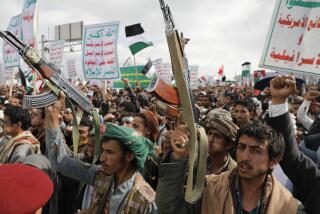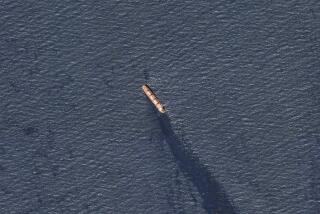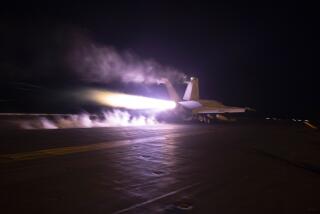Saudi Arabia hopes naval exercises in the Red Sea lead to greater clout in East Africa

Saudi Arabia stumbled to the finish line in 2018. Its war in Yemen got messier. Its reputation was severely damaged by the death of journalist Jamal Khashoggi. Its regional rival Iran solidified its power in Syria.
But as the old year gave way to the new, the desert kingdom could count at least one success: the joint naval maneuvers known as “Red Wave 1.”
These exercises, conducted in the Red Sea by Saudi Arabia and six other countries, were the first tangible product of a new Saudi-led alliance designed to encourage regional cooperation around the sea — and project Saudi power into the Horn of Africa.

Though they garnered little attention, the military maneuvers were the kingdom’s latest bid at establishing its dominance in a region — and a body of water — increasingly fractured by regional rivalries.
The killing of Khashoggi, which was widely blamed on the kingdom’s leaders and spurred its worst diplomatic crisis since the attacks on the United States on Sept. 11, 2001, has strained relations with its once reliable ally in Washington.
That has pushed Saudi Arabia to turn to the Horn of Africa to protect its western flank and develop its own security doctrine.
Working in concert with the United Arab Emirates, it has joined the scramble for influence in Africa, where the two Persian Gulf partners have built multiple military bases, portents of how they intend to project power in the future.
Those considerations have become more urgent as Saudi Arabia’s rivals — Iran, Turkey and Qatar, not to mention global powers such as China — have engineered their own footholds in countries ringing the Red Sea and especially in the Horn of Africa region.
Saudi Arabia’s then-foreign minister, Adel Jubeir, said as much during the initial announcement last month of the Red Sea alliance with Jordan, Egypt, Sudan, Somalia, Djibouti and Yemen.
“The more cooperation and coordination that you have among the countries of this region, the less negative outside influence will be on this region,” said Jubeir, without naming the source of this outside influence.
“This is part of the kingdom’s efforts to protect its interests and those of its neighbors and ... to stabilize the region that we live in and to try to create synergies between the various countries.”
As it stands now, the alliance does not include Eritrea, with its approximately 715 miles of Red Sea coastline, or Ethiopia, which, though landlocked, is the Horn of Africa’s economic heavyweight. (Both are expected to join future exercises.)
Israel, ostensibly the most powerful actor on the Red Sea, was also not invited to take part, despite evidence of its growing ties to Saudi Arabia. It remains a polarizing presence in the region.
For decades, nations on the coast of the Red Sea had little need for a common security mechanism for the simple reason that major world powers saw it as too essential to be subject to upheaval.
The waterway handles some 13% of the world’s global trade. It’s bound from the south by the Bab al-Mandeb strait, an 18-mile-wide choke point between the Middle East and the Horn of Africa through which an estimated 4.8 million barrels a day of crude oil and refined petroleum products flowed toward Europe, the United States and Asia in 2016, according to U.S. government figures.
To the north lies the Suez Canal, which connects the Red Sea to the Mediterranean and in 2016 handled 3.9 million barrels a day of crude oil and refined products, according to data published by the Suez Canal Authority.
Threats to that trade have spurred countries to work together to ensure the Red Sea remained open for shipping despite conflicts and instability.
One example was the issue of Somali pirates, whose activity on the Red Sea (which peaked between 2007 and 2012 but has been since on the wane) brought in NATO as well as 17 non-NATO nations in a joint operation to end the threat.
But in recent years, the Red Sea, and especially the coast off the Horn, has become a chessboard for Gulf states’ newfound assertiveness.
Their “ATM diplomacy,” buttressed by billions in petrodollars, has only intensified in the face of flaring tensions in the region. Saudi Arabia and the United Arab Emirates fear that turmoil from adversaries Iran, Qatar and Turkey could clog the Strait of Hormuz, their top conduit for most of their exports.
Another concern is the war in Yemen, where a Saudi-led coalition fights — with U.S. support — against Iranian-backed Houthi rebels.
These rising threats come at a time of waning U.S. engagement in the region, forcing Saudi Arabia and the United Arab Emirates to focus on their own security needs, said Elana Delozier, a Gulf expert at the Washington Institute for Near East Policy.
“The Yemen crisis, the Somalia issues, Turkey coming into Sudan, piracy, … all of these things are worrisome to the Emirates and Saudi Arabia,” Delozier said. “And whereas before they could count on the [U.S. Navy’s] 5th Fleet and a U.S. presence, they may not feel like they can anymore.”
Meanwhile, both blocs — the Saudi-Emirati alliance and its adversaries — have played a game of geopolitical checkers with the Horn of Africa’s Red Sea ports.
Last year, Qatar signed a $4-billion agreement to develop the Sudanese port of Suakin, a mere 200 miles southwest of the Saudi port of Jidda.
Turkey is there too, with a 99-year lease to restore Suakin’s Ottoman-era port, revive the area as a tourist destination for pilgrims bound for Mecca and build a naval dock that could provide the basis for military cooperation in the future, according to Sudan’s foreign minister, Ibrahim Ghandour.
The United Arab Emirates and Saudi Arabia have also been active in the area, with the former forging its own path in Africa for almost a decade.
The Emirates were the driving force behind a peace deal ending a long-running dispute between Eritrea ad Ethiopia. After Emirati forces were evicted from Djibouti in 2015, it switched its military operations to a base in Eritrea.
Over in Somalia, the Emirates took over management of the port of Bosaso in October 2017, several months after it had signed a 30-year lease for the port of Berbera in Somaliland.
Saudi Arabia, meanwhile, has agreed with Djibouti to establish a base in the small African state, the kingdom’s first foreign military outpost.
Both blocs have also dangled millions of dollars of aid before African countries in a bid to win their allegiance and expel the other side’s forces. Saudi Arabia now stands as Africa’s fifth largest investor, and more than 20 African heads of state have traveled to Riyadh to meet Saudi leader King Salman.
The establishment of the Red Sea alliance comes at a time when Saudi Arabia is pursuing mega-scale development plans on its 1,120-mile coast on the sea, part of its Vision 2030 plan aimed at weaning itself off its oil addiction and diversifying its economy.
One of those initiatives, the Red Sea Project, seeks to transform some 13,000 square miles of land near the kingdom’s western coast into a luxury tourism destination. Another is Neom, a $500-billion mega-city that will encompass land located within Jordan’s and Egypt’s borders.
More to Read
Start your day right
Sign up for Essential California for news, features and recommendations from the L.A. Times and beyond in your inbox six days a week.
You may occasionally receive promotional content from the Los Angeles Times.







